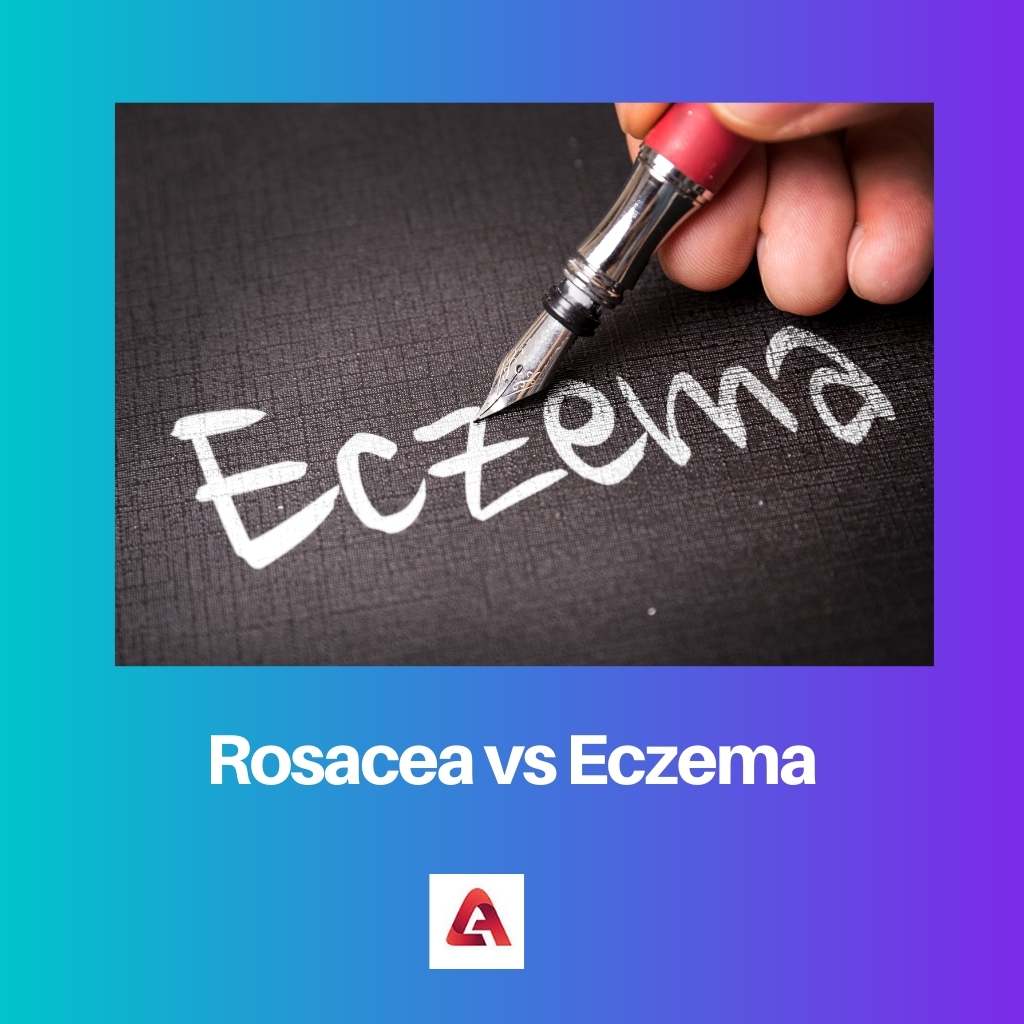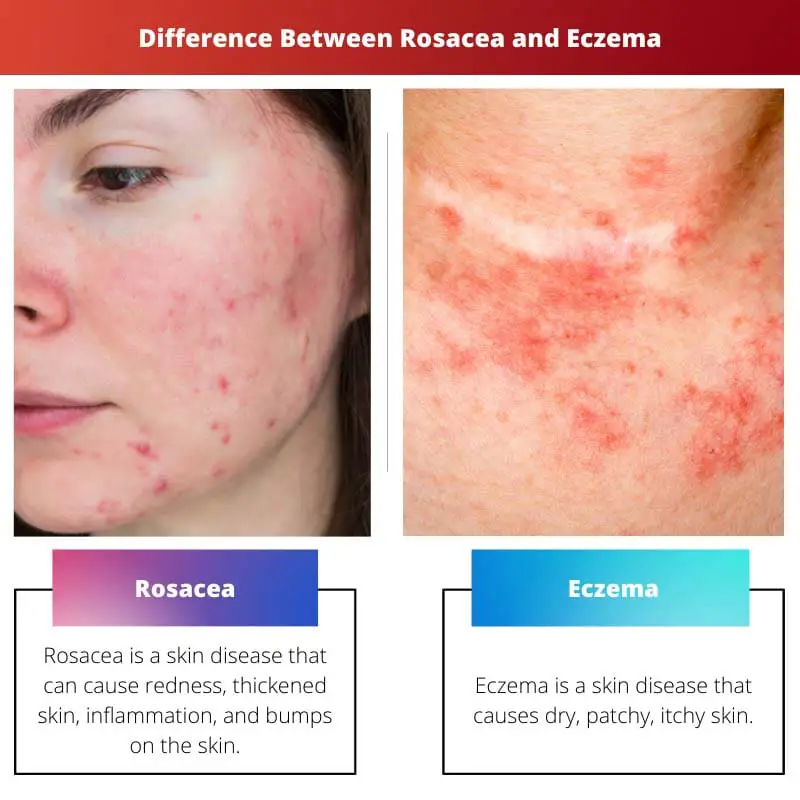Rosacea and eczema are two chronic and common skin problems with almost similar symptoms. These types of skin conditions can cause redness, itching, visible blood vessels, bumps, dry skin, etc.
As they both have almost the same symptoms, it can be hard to identify them sometimes. But there also present some key differences between the two.
Key Takeaways
- Rosacea is a chronic skin condition that causes redness and swelling on the face.
- Eczema is a chronic skin condition that causes dry, itchy, and inflamed skin.
- Rosacea is triggered by sun exposure, stress, and alcohol consumption, while allergies, irritants, and stress can trigger eczema.
Rosacea vs Eczema
Rosacea is a chronic skin condition that primarily affects the face, causing redness, flushing, and visible blood vessels. Eczema, also known as atopic dermatitis, is a chronic skin condition that can affect any part of the body, but is most common on the face, hands, and feet, it causes itching, redness, dryness.

Rosacea is a common chronic skin disease that can cause redness, skin sensitivity, and inflammation on the face. Occasionally it also causes bumps and pimples on the forehead area.
Small pus-filled lumps may also be visible in some cases. The exact cause of that skin disease is still unknown. It can be maintained by proper therapeutic care.
Eczema is another common skin condition that makes the skin excessively dry, itchy, patchy, and scaly. People with any skin type may face skin problems like eczema.
Rashes and redness can appear all over the body. Specifically, when our skin dries out and becomes more sensitive in the winter months, eczema problems can worsen.
Comparison Table
| Parameters of Comparison | Rosacea | Eczema |
|---|---|---|
| Meaning | Rosacea is a skin disease that can cause redness, thickened skin, inflammation, and bumps on the skin. | Eczema is a skin disease that causes dry, patchy, itchy skin. |
| Symptoms | Redness, itching, thickened skin, small pus-filled bumps, skin inflammation, etc. | Dry, itchy, and patchy skin with redness and rashes. |
| Affected areas | It occurs on the face, especially on the cheeks and nose bridge area. | It can occur anywhere in the body. Mostly in the elbow, back of the knees, and neck area. |
| Age limits | Generally affects 30 to 50 years old people. | It can happen in childhood and also can affect adults. |
| Skin type | Noticeable in people with fair skin tones. | People with any skin type and tone. |
| Treatment | It can be treated by oral antiseptics, topical medication, antiseptic creams, laser treatment, etc. | Topical creams, moisturizers, antibacterial creams, mild soaps, and laser therapy. |
What is Rosacea?
Rosacea is a chronic skin disorder that is characterized by redness, thickened skin, and irritated skin with small bumps or pimples.
Rosacea is perceived as blushed skin with visible blood vessels on the face. It can badly affect the cheeks, chin, and nose area.
Rosacea is more of a facial problem. This skin problem is most common in women with lighter skin types people. People with sensitive skin can experience fluid-filled bumps or acne breakouts.
Usually, people with sensitive skin can suffer from rosacea the most. It also causes tiny blood vessels on the skin.
This type of skin condition is very common in adulthood. Rosacea is not a curable disease, and the cause is still unknown. It could be due to immune systems or environmental factors.
It can be managed through prescribed antibiotics and an excellent skincare routine. Topical lotion, creams, and gels are used for rosacea treatment.
Rosacea may not be prevented, but it can be treated. If left untreated, it might get worse, and you might have to make personalized treatment from a specialist.
Adults ages 30 to 50 are mostly affected by rosacea.
What is Eczema?
Eczema is a skin condition that makes the skin itchy and red. It also makes skin dry, inflamed, and patchy. It develops in early childhood, and it’s a chronic problem.
It can appear anywhere in the body. The most common type of eczema is atopic, which can cause asthma and fever.
Eczema affected portion becomes very dry and scaly, and rashes commonly appear in the areas of knees, elbows, neck, etc. Sometimes blisters may occur. Foods like dairy and nuts can trigger symptoms.
There is no cure for eczema, but eczema symptoms can be managed by taking certain steps.
We can treat eczema by using some natural home remedies. As eczema is associated with dry skin, proper moisturization of the skin is needed to treat eczema.
Eczemas are dry and thickened, and sometimes immune systems and various environmental factors are responsible for eczema.
People should use mild or non-soap cleansers like products on eczema-affected areas and need to use a good moisturizer after taking a shower.
It is very important to follow a healthy skincare routine to maintain a clean body.
Main Differences Between Rosacea and Eczema
- Rosacea can cause thickened skin, bumpy skin, redness, itchy skin, and inflammation. On the contrary, eczema can cause dry, scaly, itchy skin with redness and rashes.
- Rosacea affects the facial skin, the cheeks, and the nose bridge area, whereas eczema can happen in any area of our body, including the face, hands, body, and legs.
- Rosacea mostly affects adults aged 30 to 50, whereas eczema begins at two years old in 60% of cases.
- Rosacea affects females with white skin tones, whereas eczema affects females and males equally with any skin tone.
- Eczema is a more common skin problem than rosacea.





